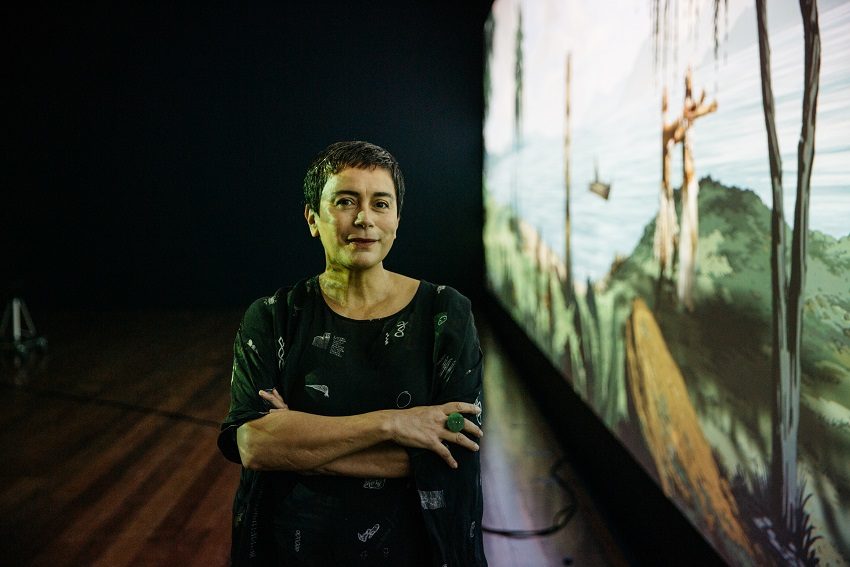Lisa Reihana’s post-colonial magic show

With the immersive In Pursuit of Venus (infected), Lisa Reihana spectacularly retrieves the hidden and suppressed voices of the colonised from imperialist narratives as part of Adelaide // International.
This is one deep and most curious rabbit hole. On entering Lisa Reihana’s In Pursuit of Venus (infected) you are wrapped in an immersive experience well outside the realm of conventional cinema. This is No-Where Land where multiple human dramas are enacted by actors who are at once figments of history and as real as the nose on your face. They look to have burst through a proscenium curtain of arcadian desire, like the actors they are, hamming it up and clamouring for attention. The challenge is, there are so many of them, disposed as vignettes across a 20-metre screen, which one moment are here and, at another, reappearing there.
This Whac-a-Mole dynamic has the effect of folding the overarching narrative of James Cook’s interaction with Indigenous peoples back into itself. And that essentially is the artist’s intent – to retrieve from imperialist narratives the hidden or alternative truths and suppressed voices of the colonised. The historical setting is James Cook’s 1769 voyage to the South Pacific to record the transit of Venus across the sun and his subsequent expeditions to claim the ‘unknown’ Terra Australis.
He was in many senses in uncharted waters. The problem was that very few visual records existed. Colonisation, and the published work of maritime artists and naturalists and the first wave of ‘settler artists’ in the early 19th century gradually informed the European imagination. But the visual databank of images continued to be filtered (or infected, Reihana might say) by a powerful desire by the colonisers to envisage arcadian landscapes peopled by ‘noble savages’ grateful for the benefits of European civilisation.
Reihana’s practice has continued to explore how identity and history are represented. In this practice, intersections of time, the distant and recent past and the present are fluid. Venus is the latest and most spectacular iteration of this approach.

This unlikely landscape has suited the artist’s purpose in destabilising the viewer’s sense of normality. The effectiveness of this ploy becomes apparent when the eyes gradually become accustomed to the action taking place within this panoramic placebo. The figures leap out of the pixilated screen with crystalline clarity.
Not only that – their actions are underscored by levels of everyday realism rarely found in colonial art. Soldiers scratch themselves and look bored. People look genuinely fearful or happy. A man is flogged on a triangle and his body quivers under the blows. Anger flares in faces of men of different races who moments earlier were dancing and joking together.
For this to happen, a lot of high-end technology had to be called in (some courtesy of Peter Jackson’s post-production studio in Wellington) and a large team of creative talents assembled. Within this team sit the talents and skills of James Pinker and Sean Cooper, co-composers of the sound track for Pursuit of Venus (infected). The soundscape adds a remarkable dimension to experiencing the video. Blended within it are not only bursts of dialogue, song and music (including the era-popular composer Bach, a penny whistle and music played on old Māori instruments) but ‘found’ sound such as the winding of one of Cook’s clocks used on a voyage. Pinker comments that the soundscape “acoustically tells the story of time shifting and the physicality of time itself”.

Producing around 70 scenarios required casting and rehearsing a large group of variously experienced actors, producing costumes and sourcing props. Action was shot against a green screen, making it possible to then ‘drop’ the action into the landscape at a later stage. Some scenarios involved a lamination of distant and foreground figure groupings. Getting shadows to ‘belong’ to both figures and ground was particularly challenging.
Since Venus was launched on the world stage at the 2017 Venice Biennale, to critical acclaim (Reihana represented New Zealand), it has continued to evolve – a gift that keeps on giving – in the tradition of Māori koha. The 2019 Adelaide // International iteration includes a welcome to country and traditional weaving sequences that resulted from the artist working with Dharawal dancers and weavers in Sydney.
Oddly enough, the experience of gazing at a panoramic screen on which phantoms enact events has much in common with the Victorian-era magic lantern events which attracted large public audiences at the time. It was their Netflix. By such means the general public and armchair travelers learnt about the wider world and exotic, faraway lands.
Venus with its restaging of chance encounters, brutality, mutual curiosity ‘lost in translations’ and moments of compelling grace and beauty – set in a 200-year-old No-Where Land, reborn through the latest digital technology, offers its audience a chance to wind back the clock and start over with fresh perspectives. And this is something that another big bronze statue can never do.
Lisa Reihana, In Pursuit of Venus (infected)
Adelaide //International
Samstag Museum of Art
Until Friday, April 5
unisa.edu.au/samstagmuseum